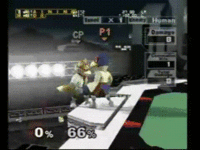Ceiling glitch
The ceiling glitch (also invisible ceiling glitch, known as Y-knockback-velocity-cancelling in Japan) is a glitch in Super Smash Bros. Melee that resets the victim's vertical knockback velocity to zero upon activation. Most commonly, this makes a character knocked upward appear to get hit by an invisible ceiling, seemingly being stage spiked downward.
Explanation
When a grounded character's attack hits a shield, the character takes a small amount of recoil speed (sometimes known as attacker shield knockback velocity), applying space between them and the shielding character. On the ground, this speed is negated quickly due to traction. However, air friction is applied incorrectly to that speed. While a character in the air has attacker shield knockback speed, a constant amount of that speed is decreased each frame. If the remaining speed is less than the amount of reduction per frame, then the speed supposedly resets to 0 instead. However, due to an error in the game's code, the vertical component of the character's normal knockback speed is set to 0 instead, while that of attacker shield knockback velocity is unchanged. As a result, if a character hits a shield and is knocked back before the attacker shield knockback has depleted, the ceiling glitch activates, and the character's vertical knockback speed is negated on the frame the attacker shield knockback should run out.
Extended Ceiling Glitch
If a character has any amount of vertical attacker shield knockback velocity in the air, then due to the same bug, that vertical component never dissipates in the air. Thus in that case once the ceiling glitch activates, the bug continuously resets the characters vertical knockback to 0 each frame, making it impossible to knock that character up or down. Landing on stage still ends this extended ceiling glitch, as traction takes care of the remaining vertical attacker shield knockback.
A character can gain vertical attacker shield knockback velocity by taking to air from a slanted surface, or by having hit a shield from the left side. The application of air friction involves usage of trigonometric operations. When those operations are applied to leftward speed, miniscule imprecisions lead to a tiny distortion in the angle of the speed. A microscopic amount of downward speed gets added to previously purely leftward speed, leading to extended ceiling glitch.
Uses
Shielding player (Player A)
Under normal circumstances, it is difficult for player A to properly recognize and react to the glitch being active on their opponent. Should they successfully notice or guess that it has occurred, however, they can plan to use horizontal or diagonal attacks as effective semi-spikes, making it very difficult for player B to recover before reaching solid ground and fixing the glitch. Should player A wish to try and inflict the glitch on their opponent, they need to act very quickly after their shield is hit, requiring a powershield, specific shield SDI, edge-cancelling, or other such technique. Alternatively, a teammate can strike player B if player A cannot react in time.
Attacking player (Player B)
If the attacking player thinks their opponent does not recognize the glitch (or cannot react fast enough to do so), they can intend to strike player A's shield and take an out-of-shield vertical KO move for minimal knockback and much confusion; one prime example is Fox's up smash, which normally has strong KO power but would simply send player B across the stage's surface while the glitch is active. Similarly, if the glitch is active, meteor smashes that have no horizontal component will simply reset player B's velocity to zero instead of dealing knockback, which can cause player A to make the wrong move after the unexpected result. This particular scenario directly resulted in S2J losing a set to Abate at The Big House 5.
Notably, Luigi's extremely low traction allows him to abuse the glitch without needing input from the opponent: if his attack deals enough damage, he can jump before he stops sliding after hitting the shield. Concurrently, Luigi is the easiest character for opponents to inflict the glitch on, though it depends on whether they can reach him.
Gallery
External links
The glitch in action on Brinstar
AsumSaus video about ceiling glitch



